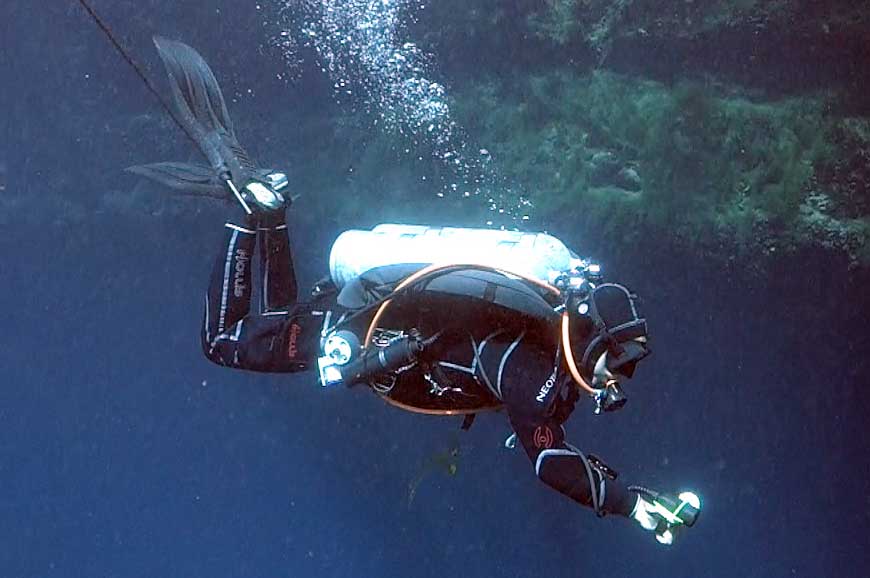![]() The “standard” flutter kick taught in Open Water Diver courses is one cave divers simply don’t use. Instead, they have a repertoire of propulsion techniques that allows them to choose the right technique for each situation. These techniques not only allow cave divers to move efficiently, they help divers avoid silting out the cave or damaging fragile formations. It is for this reason that every diver should learn these techniques, to help protect fragile coral and aquatic life as well, and keep the visibility pristine for others.
The “standard” flutter kick taught in Open Water Diver courses is one cave divers simply don’t use. Instead, they have a repertoire of propulsion techniques that allows them to choose the right technique for each situation. These techniques not only allow cave divers to move efficiently, they help divers avoid silting out the cave or damaging fragile formations. It is for this reason that every diver should learn these techniques, to help protect fragile coral and aquatic life as well, and keep the visibility pristine for others.

In this article, you’ll find four videos. In them, you will see and hear veteran cave diving instructor and NSS-CDS Training Committee member Reggie Ross both explain and demonstrate how each technique works. Reggie is an extremely gifted educator who knows that the key to learning is not to make simple things complex, but to make complex things simple. Although the context for each video is how you would use the technique presented in a cave environment, you can easily see how it would apply in technical and recreational diving as well.
Modified Flutter Kick
Using the Modified Flutter Kick is like shifting into first gear. The only time you are likely to use it is when fighting high flow.
Key points from this video:
- Unlike the standard flutter kick, when using the Modified Flutter, you keep your knees and ankles bent.
- You kick from the knees instead of the hips.
- Your knees should remain in line with your hips and shoulders, never dropping below the plane of your body.
Frog Kick
If the Modified Flutter is like first gear, the Frog Kick is overdrive. This is the “gear” cave divers use most of the time.
Key points from this video:
- The key to doing the Frog Kick is to imagine you are placing the bottoms of your fins flat against a wall behind you, then pushing away from the wall in a piston-like motion.
- At the end of the kick, bring the bottoms of your fins together, to extend the amount of thrust generated.
- The Frog Kick is the most efficient kick because it puts more surface area against more water.
- It is not a continuous kick motion. At the end of each kick, you glide before repeating the process.
- If you are doing it right, you will know it’s right because it will feel right.
Pulling
It should go without saying that this is one technique you should not use around coral or anything else alive or fragile. In high flow caves, you will use this technique more than you will any sort of kick. It also provides among the most efficient ways to move when diving on non-sensitive wrecks and rocky bottoms.
Key points from this video:
- In caves, you should not be pulling unless there is high flow. The exception is when you are doing gentle “finger pulls” on established hand holds, so that you can keep your fins still in tight, fragile passageways.
- When pulling in caves, it’s vital you grasp each rock firmly and not allow your fingertips to slip on the rock. If you do, you will quickly sandpaper off the skin, resulting in an exceptionally painful injury.
Helicopter Turn
The Helicopter Turn is how cave divers — or divers in any tight or cramped space — can change direction, including turning around in their own body’s length.
Key points from this video:
- The key to doing the Helicopter Turn is to do a Frog Kick with just a single fin.
- Practicing the Helicopter Turn can actually help improve your Frog Kick.
- Kick your right fin to turn left, and your left to turn right.
- Note that, when doing the Helicopter Turn, you do not go around in a circle, but rather pivot on your belly button.
Important points to remember
- There is no single propulsion technique that is best for every situation. Whether diving in caves, wrecks or open water, having a variety of propulsion techniques at your disposal allows you to choose the best one for conditions.
- Some of these techniques are analogous to gears in a transmission, allow you to shift into first gear or overdrive.
- Other techniques allow you to pivot like a helicopter or pull your way through high flow.
Cave diving educator extraordinaire Reggie Ross and I developed this article jointly — although the original idea and the performance are all Reggie. As you can tell from the videos, Reggie is an extremely capable educator and someone it is very easy to learn from.
Even though I don’t advertise, I still get inquiries about learning to cave dive. Due to factors ranging from, “I’m not as young as I once was,” to my video production commitments, I limit who I teach to just close friends and coworkers and refer prospective cave students to others. And, while I know a number of really good cave instructors whom I could recommend without hesitation, Reggie has always been at the top of my list. If you’ve watched the videos, you know why.
You can learn more about Reggie and the courses he offers at ReggieRoss.com.

